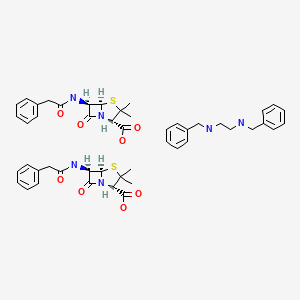CASRN: 1538-09-6

Drug Levels and Effects
Summary of Use during Lactation
Limited information indicates benzathine penicillin G produces low levels in milk that are not expected to cause adverse effects in breastfed infants. Occasionally disruption of the infant's gastrointestinal flora, resulting in diarrhea or thrush have been reported with penicillins, but these effects have not been adequately evaluated. Benzathine penicillin G is acceptable in nursing mothers.
Drug Levels
Maternal Levels. Two women received one dose of 2.4 million units of benzathine penicillin G intramuscularly 20 hours after delivery. Milk concentrations decreased from 30 units/L on the third day to 10 units/L on the fifth day. After the fifth day, milk levels were undetectable. The authors estimated that an exclusively breastfed infant would receive a maximum of 6 to 7 units daily.[1]
Infant Levels. Relevant published information was not found as of the revision date.
Effects in Breastfed Infants
A breastfed 1-month-old infant with congenital syphilis developed a Herxheimer reaction 6 hours after its mother received 2.4 million units of benzathine penicillin G intramuscularly. However, the baby had also received 10 units of penicillin G at about the same time as the mother's injection. The reaction was possibly caused by penicillin in breastmilk.[2]
Effects on Lactation and Breastmilk
Relevant published information was not found as of the revision date.
References
- 1.
- Borderon E, Soutoul J, Borderon J, et al. Excretion of antibiotics in human milk. Med Mal Infect 1975;5:373-6.
- 2.
- Rollier R, Rollier M, Bellouchi M. Herxheimer's reaction in maternal milk in early congenital syphilis. Bull Soc Fr Dermatol Syphiligr 1967;74:178-80. [PubMed: 6070262]
Substance Identification
Substance Name
Benzathine Penicillin G
CAS Registry Number
1538-09-6
Drug Class
Breast Feeding
Lactation
Milk, Human
Anti-Infective Agents
Antibacterial Agents
Penicillins
Disclaimer: Information presented in this database is not meant as a substitute for professional judgment. You should consult your healthcare provider for breastfeeding advice related to your particular situation. The U.S. government does not warrant or assume any liability or responsibility for the accuracy or completeness of the information on this Site.
Publication Details
Publication History
Last Revision: August 15, 2024.
Copyright
Attribution Statement: LactMed is a registered trademark of the U.S. Department of Health and Human Services.
Publisher
National Institute of Child Health and Human Development, Bethesda (MD)
NLM Citation
Drugs and Lactation Database (LactMed®) [Internet]. Bethesda (MD): National Institute of Child Health and Human Development; 2006-. Benzathine Penicillin G. [Updated 2024 Aug 15].